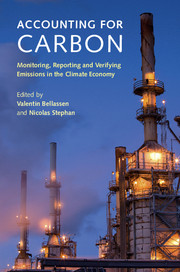Book contents
- Frontmatter
- Contents
- List of figures and map
- List of tables
- List of boxes
- Notes on contributors
- Acknowledgements
- 1 Introduction: key notions and trade-offs involved in MRVing emissions
- Part I MRV of territorial/jurisdictional emissions
- Part II MRV of industrial sites and entities
- 5 Trendsetter for companies and industrial sites: the EU Emissions Trading Scheme
- 6 Variant 1: the waste sector in Australia's Carbon Pricing Mechanism, another ETS at site level
- 7 Variant 2: non-site level emissions in an ETS–the case of electricity importers in the California cap-and-trade
- 8 Variant 3: emissions of a company/institution rather than a site: the case of the Shenzhen ETS
- 9 Variant 4: coexistence of voluntary and mandatory frameworks at the company level - Carbon Disclosure Project, EU ETS and French legal requirements
- 10 Direct measurement in the EU ETS
- Part III MRV at offset project scale
- Index
- References
6 - Variant 1: the waste sector in Australia's Carbon Pricing Mechanism, another ETS at site level
from Part II - MRV of industrial sites and entities
Published online by Cambridge University Press: 05 March 2015
- Frontmatter
- Contents
- List of figures and map
- List of tables
- List of boxes
- Notes on contributors
- Acknowledgements
- 1 Introduction: key notions and trade-offs involved in MRVing emissions
- Part I MRV of territorial/jurisdictional emissions
- Part II MRV of industrial sites and entities
- 5 Trendsetter for companies and industrial sites: the EU Emissions Trading Scheme
- 6 Variant 1: the waste sector in Australia's Carbon Pricing Mechanism, another ETS at site level
- 7 Variant 2: non-site level emissions in an ETS–the case of electricity importers in the California cap-and-trade
- 8 Variant 3: emissions of a company/institution rather than a site: the case of the Shenzhen ETS
- 9 Variant 4: coexistence of voluntary and mandatory frameworks at the company level - Carbon Disclosure Project, EU ETS and French legal requirements
- 10 Direct measurement in the EU ETS
- Part III MRV at offset project scale
- Index
- References
Summary
Acknowledgements: We are grateful to Mark Hunstone (National Inventory Systems and International Reporting Branch) for his answers to our questions and his review of the NGER Measurement Determination elements.
Context
In 2010, the waste sector in Australia reported emissions of around 15 Mt CO2e – mainly in the form of methane and nitrous oxide – and was responsible for 3 percent of Australia's greenhouse gas (GHG) emissions. Although this may appear as a negligible part of national emissions, Australia chose to include this sector in its Carbon Pricing Mechanism (CPM) as an incentive to promote recycling, alternative waste treatment, composting and capturing methane for destruction or use in electricity generation. In addition, the waste sector presents a number of opportunities for cost effective abatement according to Australia's plan for a Clean Energy Future (Ministry of Finance, 2011). For example, methane capture is a common practice in the solid waste and wastewater sectors in order to generate renewable energy. More explicitly, the scheme covers carbon dioxide, methane and nitrous oxide emissions from solid waste (accounting for 80 percent of the waste emissions), wastewater treatment (most of the remainder) and incineration (0.2 percent of the waste emissions). The CPM is directly inspired by the Carbon Pollution Reduction Scheme bill (CPRS) which failed to gain adequate support in either the Australian Parliament or the Senate (2008–2010). The CPRS was supposed to be an emissions trading scheme covering 80 percent of GHG emissions (767 facilities).
Australia's Carbon Pricing Mechanism was launched on July 1st, 2012 and was terminated by the new government on July 17th, 2014. It consists of a carbon tax over the first three years and was initially intended to be recast as a cap-and-trade mechanism from July 1st, 2015. As of September 2013, Australia's CPM was the only Carbon Pricing Mechanism worldwide to directly cover the whole waste sector. However, in 2015, the new South Korean Emission Trading Scheme (ETS) will also cover the waste sector but, as of February 1st, 2014, we are not aware of further details on the associated MRV procedures.
- Type
- Chapter
- Information
- Accounting for CarbonMonitoring, Reporting and Verifying Emissions in the Climate Economy, pp. 190 - 220Publisher: Cambridge University PressPrint publication year: 2015

